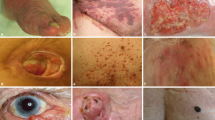Summary
Cutaneous symptoms (seborrhoea and hyperhidrosis) in Parkinson’s disease were investigated. In 70 treated patients with Parkinson’s disease and 22 control subjects, non-invasive bioengineering methods (sebumetry, corneometry, pH) were carried out on the forehead, sternum and forearm. In addition, concomitant dermatoses and medication were recorded. 18.6% of the patients had seborrhoea on the forehead (τ220µg/cm2), 51.4% showed normal sebum values (100–220 µg/cm2) and 30% a sebostasis (<100µg/cm2). Males has significantly higher sebum values than females. No relationship between the seborrhoea and the therapy for Morbus Parkinson was found. Patients with hyperhidrosis (n=36) had significantly lower pH values (p<0.05) on the forehead than those without hyperhidrosis. 22 patients (31.9%) reported a cold/hot flush and a further 13 (18.8%) had clinical rosacea. Seborrhoea is rare in treated Parkinsonian patients but hyperhidrosis is frequently found. Furthermore, a particular lack of vasostability (flush) appears to be an autonomie dysregulation in the skin related to Morbus Parkinson, which has not been studied to any extent to date.
Similar content being viewed by others
References
Baas H, Fischer PA (1984) Salbengesicht. Zentrale Dysregulation der Talgsekretion beim Parkinson-Syndrom. In: Fischer PA (Hrsg) Vegetativstörungen beim Parkinson-Syndrom. Editiones Roche, Basel, pp 221–223
Barel AO, Clarys P (1995) Measuring of epidermal capacitance. In: Serup J, Jemec GB (eds) Handbook of non-invasive methods and the skin. CRC Press, Boca Raton, pp 165–170
Burton JL, Shuster S (1970) Effect of L-dopa on seborrhoea of Parkinsonism. Lancet ii: 19–20
Burton JL, Cartlidge M, Cartlidge NEF, Shuster S (1973) Sebum excretion in Parkinsonism. Br J Dermatol 88: 263–266
Cohn T (1920) Encephalitis ohne Lethargie während der Grippeepidemie. Zentr Bl Neurol 38: 260–264
Cotterill JA, Cunliffe WJ, Williamson B (1971) Sebum-excretion rate and skin-surface lipid composition in Parkinson’s disease before and during therapy with levodopa. Lancet i: 1271–1272
Dikstein S, Zlotogorski A (1994) Measurement of skin pH. Acta Derm Venereol [Suppl] 185: 18–20
Diepgen TL, Fartasch M, Hornstein OP (1991) Kriterien zur Beurteilung der atopischen Hautdiathese. Dermatosen 39: 79–83
Freedman RR, Woodward S, Sabharwal SC (1990) Alpha 2-adrenergic mechanism in menopausal hot flushes. Obstet Gynecol 76: 573–578
Gomez-Mancilla B, Boucher R, Bedard PJ (1991) Effect of clonidine and atropine on rest tremor in the MPTP monkey model of parkinsonism. Clin Neuropharmacol 14: 359–366
Kohn SR, Pochi PE, Strauss JS, Sax DS, Feldman RG, Timberlake WH (1973) Sebaceous gland secretion in Parkinson’s disease during L-dopa treatment. J Invest Dermatol 60: 134–136
Kolev OI, Pedersson S, Nilsson G, Tibbling L (1997) Cold caloric microcirculatory reflex disturbance in patients with Parkinson’s disease. Clin Auton Res 7: 81–83
Levell MJ, Cawood ML, Burke B, Cunliffe WJ (1989) Acne is not associated with abnormal plasma androgens. Br J Dermatol 120: 649–954
Mano Y, Nakamuro T, Takayanagi T, Mayer RF (1994) Sweat function in Parkinson’s disease. J Neurol 241: 573–576
Martignoni E, Godi E, Pacchetti C, Berardesca E, Vignoli GP, Albani G, Mancini F, Nappi G (1997) Is seborrhea a sign of autonomie impairment in Parkinson’s disease? J Neural Transm 104: 1295–1304
Pochi PE, Strauss JS, Mescon H (1962) Sebum production and fractional 17-ketosteroid excretion in Parkinsonism. J Invest Dermatol 38: 45–51
Poewe W, Gerstenbrand E (1986) Klinische Subtypen der Parkinson-Krankheit. Wien Med Wochenschr 136: 384–387
Villares JCB, Carlini EA (1989) Sebum secretion in idiopathic Parkinson’s disease: effect of anticholinergic and dopaminergic drugs. Acta Neurol Scand 80: 57–63
Walton S, Cunliffe WJ, Keezkes K, Early AS, McGarrigle HH, Katz M, Hull UK (1995) Clinical, ultrasound and hormonal markers of androgenicity in acne vulgaris. Br J Dermatol 133: 249–253
Wintzen M, Gilchrest BA (1996) Proopiomelanocortin, its derived peptides, and the skin. J Invest Dermatol 106: 3–10
Author information
Authors and Affiliations
Rights and permissions
About this article
Cite this article
Fischer, M., Gemende, I., Marsch, W.C. et al. Skin function and skin disorders in Parkinson’s disease. J Neural Transm 108, 205–213 (2001). https://doi.org/10.1007/s007020170088
Received:
Accepted:
Issue Date:
DOI: https://doi.org/10.1007/s007020170088




